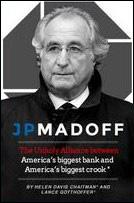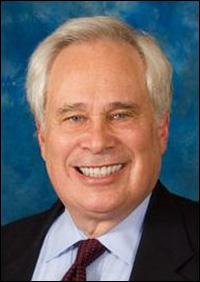By Pam Martens and Russ Martens: August 13, 2014
 Helen Davis Chaitman is a nationally recognized litigator and author of The Law of Lender Liability. And she is two other things as well – a Bernie Madoff victim who lost a large part of her life savings to his Ponzi scheme and the tenacious lawyer who represented other victims of his fraud in district and appellate courts.
Helen Davis Chaitman is a nationally recognized litigator and author of The Law of Lender Liability. And she is two other things as well – a Bernie Madoff victim who lost a large part of her life savings to his Ponzi scheme and the tenacious lawyer who represented other victims of his fraud in district and appellate courts.
Now, together with attorney Lance Gotthoffer, Chaitman has written a book titled JPMadoff: The Unholy Alliance Between America’s Biggest Bank and America’s Biggest Crook. The book is being made available to readers on a new web site which will provide a chapter each month. The first chapter is currently available and Chaitman says that the second chapter, to be posted on September 12, will detail what JPMorgan knew and when it knew it.
The web site also provides a quick means of contacting your legislator in Washington to urge Congress to “act in the interests of the American people, not in the interests of the financial institutions that are rich enough to make significant contributions.”
It is universally agreed among these authors, the prosecutors and the trustee for the Madoff victims’ fund that JPMorgan Chase (or its predecessor banks) stood at the center of the fraud as Madoff’s commercial bank for more than 20 years. It’s the lack of criminal prosecutions against the JPMorgan wrongdoers that has incensed these attorneys to launch the book and web site.
The authors explain their position in the book’s foreward:
“Madoff could not have stolen $64.8 billion of other people’s money without the complicity of a major financial institution. Madoff was able to get by with a three-person accounting firm working out of a store front in a shopping center in Rockland County, New York. But make no mistake about it. Madoff needed the imprimatur and facilities of a major bank. And JPMorgan Chase stepped up to the plate. Why would the bank do this? Shall we follow the money? Do you have any idea how much money JPMorgan Chase was able to make off the Madoff account? Did you know that Madoff maintained huge balances in his JPMorgan Chase account, reaching $4 billion or more from 2006 on. And do you think the folks at JPMorgan Chase know how to make money off other people’s money? You bet they do.
“The facts — which we lay out in this book — compel the conclusion that senior officers of JPMorgan Chase knew that Madoff was misappropriating customer funds and knew who all the victims were. There were 12 people who worked for Madoff who knew about Madoff’s embezzlement of money belonging to innocent investors. Outside of Madoff’s offices, nobody knew — for 20 years. Nobody, that is, except the people at JPMorgan Chase who were responsible to monitor the activities in Madoff’s account. They saw that, from 1986 to December 2008, Madoff deposited into his JPMorgan Chase account approximately $150 billion of funds — from upstate New York union pension funds, from charities, from corporate pension plans, from individual I.R.A. accounts. Bank officers knew that Madoff was an SEC-regulated broker who was retained by his customers to purchase securities for them. Yet, they saw no transactions in Madoff’s account indicating that he was purchasing securities for his customers. Instead, billions of dollars went to Madoff’s co-conspirators, or were wired overseas.”
Under the author section, Chaitman provides more detail on why she feels JPMorgan got off so easily:
“The most glaring example of the corruption of American values by the financial services industry is the government’s recent refusal to prosecute any individual at JPMorgan Chase for providing banking services to Bernard Madoff for almost 20 years with knowledge that he was dishonest. The prosecutor was Preet Bharara, formerly chief counsel to Senator Schumer who has enjoyed, over the years, a flow of political contributions from the entire Madoff family and from JPMorgan Chase.”
In January of this year, Wall Street On Parade completed months of research into court filings that detailed JPMorgan’s involvement in the Madoff fraud. Our conclusion was that there was not just a Ponzi scheme taking place but a series of frauds that sprang from the original fraud in a Russian nesting doll form of structure. (Read the full article.)
One of the most damning pieces of evidence suggesting that JPMorgan prolonged the Madoff fraud, allowing him to suck in more innocent victims, was a report from the trustee for the Madoff victim fund, Irving Picard, that JPMorgan Chase used unaudited financial statements to make $145 million in loans to Madoff’s business. Lawyers for the Trustee write further that from November 2005 through January 18, 2006, JPMorgan Chase loaned $145 million to Madoff’s business at a time when the bank was on “notice of fraudulent activity” in Madoff’s business account and when, in fact, Madoff’s business was insolvent. The reason for the JPMorgan Chase loans resulted from the fact that Madoff’s business account was “reaching dangerously low levels of liquidity, and the Ponzi scheme was at risk of collapsing.”
You will note as you read the background information on the Chaitman-Gotthoffer web site that the attorneys refer to a “$64.8 billion” Madoff fraud, not the $17.5 billion figure used by Madoff Trustee, Irving Picard, and major business media.
The dramatic difference in the two numbers is that Picard is using the figure for the amount of original principal he believes to have been invested with Madoff. Chaitman and Gotthoffer are using the gross amount Madoff showed on his client statements as his customers’ account balances.
The $64.8 billion figure is a valid calculation for this reason: money has a time value. Some investors started with Madoff as far back as 30 years ago. If they had placed those funds in something as simple as a savings account or a Treasury bill, they would have compounded and grown significantly. To call it a $17.5 billion fraud ignores 30 years of compound interest or legitimate stock market returns that could have been achieved had Madoff actually invested the money.
The media’s willingness to reduce the fraud to the $17.5 billion figure may have something to do with putting the best face possible on the recoveries for victims. To date, Picard has recovered $9.825 billion and made distributions of $5.259 billion. Richard Breeden, the Special Master for the U.S. Department of Justice, is administering another Madoff victim fund consisting of $4 billion in forfeited assets recovered from persons involved in the fraud. That brings the total current recoveries to $13.825 billion – which doesn’t sound too bad versus a $17.5 billion fraud but would represent only 21 percent of the statement value of $64.8 billion.
Chaitman and Gotthoffer provide another salient point in their book foreward, writing:
“It is almost six years since Madoff confessed and yet, Madoff has never testified under oath; no one from JPMorgan Chase has testified under oath…The big question is whether Americans are going to continue to tolerate criminal conduct in its financial institutions. We know the government will; the question is whether the American people will.”
This new web site, with its quick link to communicate with your members of the House and Senate, is a hopeful message that Americans are starting to fight back.



